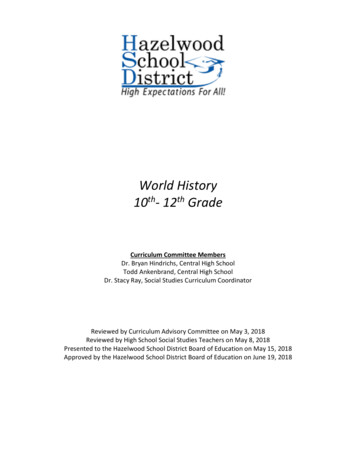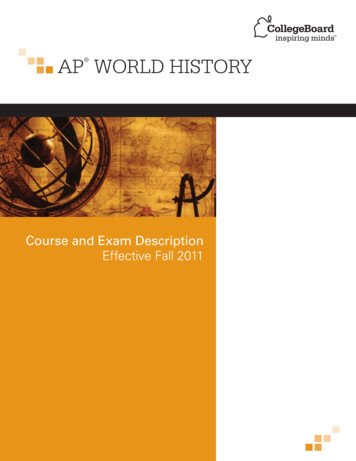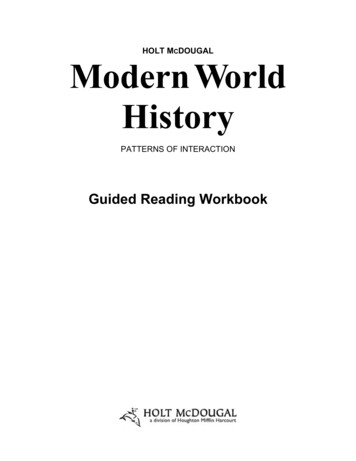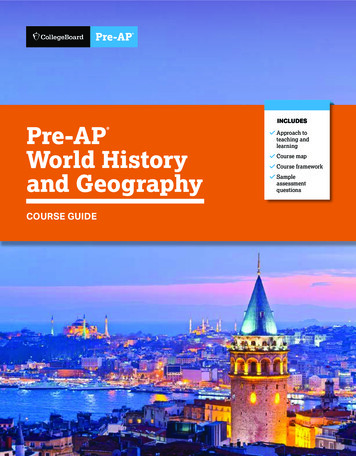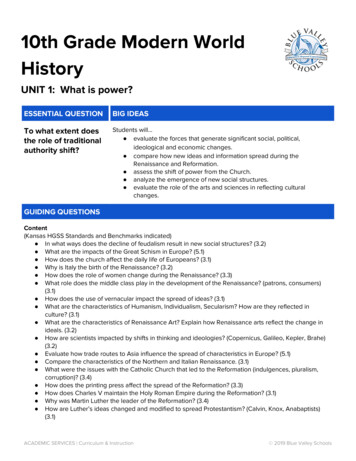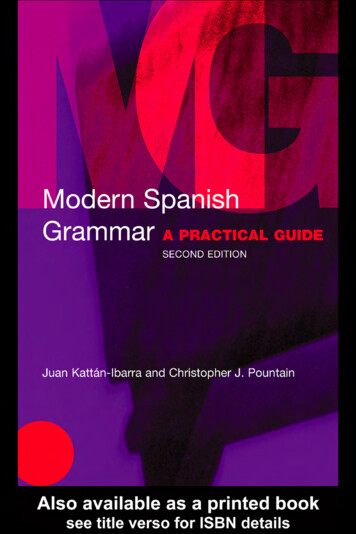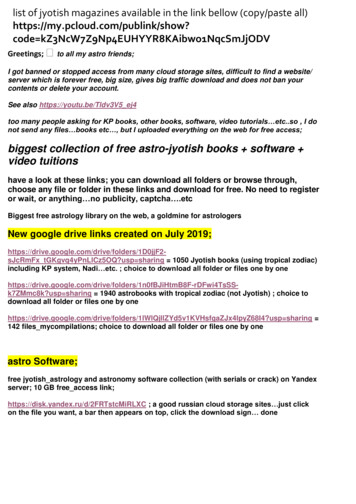
Transcription
AP WORLD HISTORYModern Course(2019)Summit High SchoolSummit, NJGrade Level / Content Area:12 th GradeAP World HistoryRevised 2019Developed byAshley M. SularzJohn R. KratchSummit High School2013-2019
Length of Course:30 weeks of active teaching new material before the AP Examination2 weeks of review before the AP Examination3 weeks following the AP examination (special projects)Course Reference:College Board. AP World History: Course and Exam Description : rse ap-world-history-modernCourse of Study:This course follows a chronological development that begins around 8,000 B.C.E to thepresent day. The periodization and pace of the course is as follows:Unit 1: The Global Tapestry, c. 1200. to c. 1450,8-10% (2 weeks)Unit 2: Networks of Exchange, c. 1200 to c. 14508-10% (2 weeks)Unit 3: Land-Based Empires, c. 1450 to c. 175012-15% (3 weeks)Unit 4: Trans-Oceanic Interactions, c. 1450 to c. 175012-15% (5 weeks)Unit 5: Revolutions, c. 1750 to c. 190012-15% (5 weeks)Unit 6: Consequences of Industrialization, c. 1750 to c. 190012-15% (5 weeks)Unit 7: Global Conflict, c. 1900-Present8-10% (3 weeks)Unit 8: Cold War and Decolonization, c. 1900-Present8-10% (3 weeks)Unit 9: Globalization, c. 1900-Present8-10% (2 weeks)Unit 10 Post AP Examination(3-4 Weeks)2
Course Description:AP World History: Modern is a full year survey course meant to be the equivalent of afreshman college course and can earn students college credit. This course will cover theevolution of cross-cultural global contacts and examine the way in which the world’s majorcivilizations have interacted since 1200 C.E. The AP World History: Modern course requiresstudents to engage with the dynamics of continuity and change across the historical periodsincluded in the course. Students will analyze cause and effect relationships and will engage incomparisons across cultures and time periods.Students in the AP program do a considerable amount of reading in both the principal textand supplemental materials. Most reading assignments will be on a college level. Evidence ofthis reading must be demonstrated through frequent and meaningful class discussions,cooperative-learning activities, and in class projects. Very often, s tudents will be required tocompare and analyze the viewpoints of historians . Reading material will also be assessed viaa variety of methods to achieve mastery of AP-style multiple choice questions , the completionof AP style short answer questions, document based questions, and longer essay questionsthat will consider causation, comparison, or change over time. Throughout the course,formative and summative assessments will reflect the skills necessary for success on the APWorld History Examination. Students in AP World History follow the suggested CollegeBoard curriculum-pacing guide which includes two weeks of review prior to the APexamination in May.Research in depth is an activity that differentiates the AP program from regular historycourses. Student research will be conducted outside of class and will culminate in a researchproject in May and June. Throughout the research process, students will be assisted in usingtechnology to access and assess topic appropriate information. In addition, students will beexpected to complete a number of 2-5 page analytical papers as in the form of DocumentBased Questions (DBQ’s), Change Over Time (COT) essays and Comparison (C&C) essayson a variety of topics relevant to AP World History requiring outside research throughout thecourse. Students are required to complete a summer reading assignment and project before thecommencement of the course in order to review and prepare for thinking about the ‘Big Ideas’ ofWorld History.Course Themes:In AP World History, students will focus on Six overarching themes that serve throughoutthe course, as unifying threads, helping students to put what is particular about each period orsociety into a larger framework. The themes also provide ways to make comparisons over timeand facilitate cross-period questions. Each theme should receive approximately equal attentionover the course of the year. The themes are: Humans and The Environmento Demography and disease3
o Migrationo Patterns of settlement Development and Interaction of Cultureso Religionso Belief systems, philosophies and ideologieso Science and technologyo The arts and architecture Governanceo Internal and external factors that contribute to state formationo Political structures and forms of governanceo Maintenance of ordero Exercise of power Creation, Expansion and Interaction of Economic Systemso Agricultural and pastoral productiono Trade and commerceo Labor systemso Industrializationo Capitalism and socialism Development and Transformation of Social Structureso Gender roles and relationso Family and kinshipo Racial and ethnic constructionso Social and economic classes Technology and Innovation o Efficiencyo Standard of Livingo ProgressThe Four Historical Thinking Skills:To assist a student’s understanding of the FIVE THEMES , the AP World History courseaddresses and develop FOUR HISTORICAL THINKING SKILLS essential in supporting astudent’s deep comprehension and relevant application of historical knowledge. The fourhistorical thinking skills presented in the course (as described below) provide an essentialstructure for learning to think historically. Skill #1 - Crafting Historical Arguments from Historical Evidenceo Historical Argumentation – the ability to define and frame a question about thepast and to address that question through the construction of an argument4
requiring a clear, comprehensive and analytical thesis supported by relevanthistorical evidence.o Appropriate Use of Relevant Historical Evidence – the ability to identify,describe, and evaluate evidence about the past from diverse sources with respectto content, authorship, purpose, format and audience. This involves the capacityto extract useful information, make supportable inferences and draw appropriateconclusions while understanding such evidence in its context, recognizing itslimitations and assessing the points of view it reflects. Skill #2 – Chronological Reasoningo Historical Causation – the ability to identify, analyze, and evaluate therelationships between multiple historical causes and effects, distinguishingbetween those that are long-term and proximate, and among coincidence,causation and correlation.o Patterns of Continuity and Change Over Time - the ability to identify, analyze,and evaluate the dynamics of historical continuity and change over periods oftime of varying lengths, as well as relating these patterns to larger historicalprocesses or themeso Periodization - the ability to identify, analyze, evaluate, and construct models ofhistorical periodization that historians use to categorize events into discrete blocksand to identify turning points, recognizing that the choice of specific datesprivileges one narrative, region or group over another narrative, region or group;therefore, changing the periodization can change a historical narrative. Moreover,the particular circumstances and contexts in which individual historians work andwrite shape their interpretation and modeling of past events. Skill #3 - Comparison and Contextualizationo Comparison – the ability to describe, compare and evaluate multiple historicaldevelopments within one society, one or more developments across or betweendifferent societies, and in various chronological and geographic contexts. It alsoinvolves the ability to identify, compare, and evaluate multiple perspectives on agiven historical experience.o Contextualization – the ability to connect historical developments to specificcircumstances of time and place, and to broader regional, national, or globalprocesses. Skill #4 – Historical Interpretation and Synthesiso Interpretation – the ability to describe, analyze, evaluate, and create diverseinterpretations of the past – as revealed through primary and secondary sources –through analysis of evidence, reasoning, contexts, points of view, and frames ofreference.o Synthesis – the ability to arrive at meaningful and persuasive understandings ofthe past by applying all of the other historical thinking skills, by drawingappropriately on ideas from different fields of inquiry or disciplines and by5
creatively fusing disparate, relevant (and perhaps contradictory) evidence fromprimary sources and secondary works. Additionally, synthesis may involveapplying insights about the past to other historical contexts or circumstances,including the present.Geographical Coverage:6
Students need basic geographical knowledge in order to understand world history. Geospatialawareness if fundamental knowledge necessary for students to build an understanding ofcross-cultural contacts, trade routes, migrations, etc., which constitute the key concepts in the APWorld History Course. The maps also are a reference point for teachers and students alike.Since geographic naming conventions are not universal, these maps define regions, so thelocations of regions, and the names that students will encounter on the AP Exam. The two mapsthat follow give students a starting point for identifying regions and their locations relative toother regions and landforms.7
Unit 1: The Global Tapestryc. 1200-1450 CE.Standard 6.2 World History/Global StudiesAll students will acquire the knowledge and skills to think analytically and systematically about howpast interactions of people, cultures, and the environment affect issues across time and cultures. Suchknowledge and skills enable students to make informed decisions as socially and ethically responsibleworld citizens in the 21st century.Big Ideas: Course Objectives / Content Statement(s) Course Introduction: Historiography, Periodization, Themes & Skills Questions of Periodization for Unit 1 – c. 1200 to c.1450 C.E. The Development, refinement and spread of Religious and Cultural Traditions Emergence the Yuan and Ming Dynasties The Delhi Sultanate Feudal Japan The Emergence of Vietnam Post-Classical, Pre-Columbian Civilizations The rise of national monarchies in Europe Cross cultural comparisons for c. 1200-1450Essential QuestionsWhat provocative questionswill foster inquiry,understanding, and transferof learning?Enduring UnderstandingsWhat will students understand about the big ideas?Students will understand that Why this periodization?It is important to understand why historians view history with the useof periodization and to understand that there is not one right way toorganize history. For this course, World History divides into fourchronological periods. This unit begins around 1200 C.E. In thisperiod the “known” world is more integrated than ever through themovement of nomads (especially the Mongols), long-distance trade,and the continued spread of religions. By 1450 C.E, the world shiftsonce more as Europeans look outward and explore the world with thehelp of ‘southern’ technology and ideas.How does the interactionbetween the environmentand humans affect eachother?Aspects of physical geography often defined the borders ofcivilizations. Contacts and sustained communications between regionsarose. Often contacts were across seas, along coasts and rivers, and theplains or steppes between regional centers. During this period, EasternHemisphere areas that had not been in contact with the great8
civilizations of the earlier age were settled and brought into contactwith the core centers of civilizations. This resulted from thetremendous growth of long distance trade due to the improvements intechnology. The environment also played a role in the human decisionmaking process as states from this period made many importantdecisions in response to environmental changes. One example includesthe great movement of peoples like the Bantus, Polynesians, Turks, andMongols, who greatly altered our world. One of the worst epidemicdiseases in history, the Bubonic Plague (Black Death), spread duringthis period due to the movement of people & increased interaction.How do political systemsform, grow, change, andrelate to each other?Following the collapse of classical empires, the political structures ofmany areas adapted and changed to meet new conditions. Centralizedempires like Byzantium, the Islamic Caliphates, the Song and Mingdynasties of China, and the Toltecs and Aztecs of Meso-America, builtoff the successful models of the past. Decentralized areas like WesternEurope and Japan developed political organization that moreeffectively dealt with their unique issues. In South America, apowerful Inca state in the Andean region. The movements of theMongols altered much of Asia’s political structure for a time. Finally,the recovery from the Mongol period introduced political structuresthat defined many areas for centuries to follow.How do economic systemsdevelop and what did theydepend on?Agriculture continued to expand and develop to different parts of theworld. Societies organized their labor systems to suit their needs tosatisfy demands for food. For example, Western Europe developed alocalized manor/feudal system, while the Byzantine or Song developeda centralized tax system to allocate resources to sustain their Empire.Long distance trade also expanded over many regions in the world.Facilitating this expansion of trade over land and sea were newtechnologies, new monetary systems, new trade routes, and new tradepractices going beyond and spreading among cultures. Overall,productivity rose in both agriculture and industry, supportingpopulation growth and urbanization but also strained environmentalresources and at times caused dramatic demographic swings.How do societies organizethemselves socially andwhat role do men andwomen play?Although most societies continued to reinforce their patriarchal natureand strict social structure, the spread of universal religions had someeffects. Religions such as Islam, Christianity, and Buddhism preachedthe equality of all believers and this seemed to be the case, at least, inthe eyes of God. The monastic life of both Buddhism and Christianityoffered an alternative for women to gain some independence andeducation.9
How do cultures developand what happens whenthey interact with eachother?The spread of religion during this time period often acted as a unifyingcultural force. For example, Christianity and the Church served as thecentralizing force in Western Europe during most of this period. Inaddition, the spread of Confucianism and Buddhism throughout EastAsia solidified a cultural identity in those areas. The new religion ofIslam created a new cultural world known as Dar al-Islam thattranscended political boundaries. This time period also witnessed atremendous growth in long-distance trade through the Silk Road, theIndian Ocean, Trans-Saharan trade, and the Mediterranean Seaspreading goods, ideas, technology and styles of art & architecture.Additionally, nomadic migrations of groups like the Mongols causedmajor change throughout the world either disrupting or solidifying thetrade networks.Areas of Focus: Proficiencies(Cumulative Progress Indicators)Students will:NJCCS: (2009)4. The Global 8.D.4.f6.2.8.D.4.gKey Conceptual Objectives:Continue to develop an understanding ofhistorically thinking with a globalperspective by comprehending the fiveAP World History Themes, the FourHistorical Thinking Skills andGeographical Coverage of the course. Consider this unit’s significant themespresent in historical analysis & thediverse interpretations of those themes. Identify the significant changes in worldgeography and locate the major Examples, Outcomes, AssessmentsInstructional Focus (3 weeks):A. Course Introduction: Historiography,Periodization, Themes & SkillsB. Summer Assignment Review/AssessmentC. The Ottoman EmpireD. The Impact of Interactions Among CulturalSpheresE. Unit 1 Review & AssessmentSample Assessments: AP Style Multiple Choice Quizzes and Tests Document Based Question (DBQ)Example: Christianity & Islam – Using thedocuments, compare and contrast the attitudes ofChristianity and Islam toward merchants and tradefrom the religions’ origins until about 1500. Are thereindications of change over time in either case, or both?What kinds of additional documents would you need toassess the consequences of these attitudes on merchantactivities?Example: Buddhism in China – Based on thefollowing documents, analyze the responses to thespread of Buddhism in China. What additional kind ofdocument(s) would you need to evaluate the extent ofBuddhism’s appeal in China?10
civilizations and political units for theperiod c.1200 C.E. to 1450.Explain the origins, refinement, andexpansion of Confucianism, Buddhism,Christianity, and Islam.Discuss how empires collapsed and werereconstituted; in some regions new stateforms emerged by outlining the keypolitical, economic features, social, andcultural features and developments ofthe key centralized and decentralizedstates of Europe, Asia, Africa, and theAmericas.Analyze how interregional contacts andconflicts between states and empiresencouraged significant technological andcultural transfers.Describe how improved transportationtechnologies and commercial practicesled to an increased volume of trade, andexpanded the geographical range ofexisting and newly active tradenetworks.Explain how the movement of peoplescaused environmental and linguisticeffects.Evaluate how cross-cultural exchangeswere fostered by the intensification ofexisting, or the creation of new,networks of trade and communication.Trace the rise, apex, and fall of theMongol empire and assess their impactupon major Eurasian civilizations andworld history.Discuss how trade routes continued todiffuse crops and pathogens throughoutthe Eastern Hemisphere.Identify ways how innovationsstimulated agricultural and industrialproduction in many regions.Analyze how the fate of cities variedgreatly, with periods of significantdecline, and with periods of increasedurbanization buoyed by rising Continuity & Change Over Time Essay (CCOT)o Example: Mode of Production –Example: Silk Road – Analyze continuities andchanges in patterns of interactions along the SilkRoads from 200 BCE to 1450 CE. Comparison EssayExample: Mongol Rule – Compare and contrast thepolitical and economic effects of Mongol rule on TWOof the following regions: China / Middle East / RussiaSample Instructional Strategies: Interdisciplinary Connections/CulturallyResponsive Teachingo Literature:- Admonitions: St. Francis ofAssisi- Summa Theologica: ThomasAquinas- Precepts for Social Life: YuanTs’ai- The Book of the Maghrib: IbnSaid- The Muqaddimah: Ibn Khaldun- The Life and Travels of IbnBattuta: Ibn Battuta- The chronicle of The Seeker:Mahmud Kati- Rock and Pillar Edicts: Asoka- A Record of Musings on TheEastern Capital: Southern Song- On Life and Death: Dogan- Treatise on Royal and PapalPower: John of Paris- Journey to The Land of theTartars: William of Rubruck- Description of The World: MarcoPolo- The Practice of Commerce:Francesco Pegolotti- The Overall Survey of TheOcean’s Shores: Ma Huan11
productivity and expanding tradenetworks. Explain how despite significantcontinuities in social structures and inmethods of production, there were alsosome important changes in labormanagement and in the effect ofreligious conversion on gender relationsand family life.Technology Integration - Wiki Page: Studentscreate a Wiki explaining the main accomplishments ofONE of the following regions/societies from c. 600 CEto 1450 by following the 5 main themes of AP WorldHistory: Aztecs, Mayans, West Africa or East Africa.Global Perspective – Socratic Seminar: & discussthe following question in class – Hold an inner-outer circle discussionabout World Systems. In preparation,students were to have read & analyzedthe following articles: Abu-Lughod, Janet L.,“Restructuring the Thirteenth –Century World System.” Shaffer, Lynda Norene,“Southernization.”21 st Century Skills: Creativity and Innovationo News Reporter - Students create, film and edit a news report about an importanttechnological innovation from this period – Example: Discovery of Fire. Critical Thinking and Problem Solvingo Be the Archeologist – Examine a corresponding archeological map and artifact sheetto elicit evidence/facts and inferences/meaning about a mystery human society. Communication and Collaborationo Culture Mural – In groups of three, students create a mural on large poster boardanswering the following question: What is culture? How do you define it? Information Literacyo Map Projections – Analyze various map projections to understand ‘diverseinterpretations’ of world history: Mercator, Equal Area, Interrupted, Polar, Equal Area,Upside-down, Geographical, Climate, etc. Media Literacyo Web Quest – Analyze. Life and Career Skills21 st Century Themes (as applies to content area) Financial, Economic, Business, and Entrepreneurial Literacyo Organizing Labor & Resources – Compare how the core civilizations ofMesopotamia, Egypt, the Shang and the Olmecs mobilized surplus labor and resources. Civic Literacy12
o Claiming the Authority to Rule – Examine what gives a leader in a society theauthority to rule by examining the examples of Egypt’s pharaohs, the priest-kings ofMesopotamian city-states & the Chinese Mandate of heaven. Health Literacyo Letter to the Editor – Read Jared Diamond’s article “The Worst Mistake in theHistory of the Human Race,” and write a letter to the editor in response to Diamond’sidea that the decision to settle down and farm was the worst mistake in Human History.S.T.E.A.M (Science, Technology, Engineering, Arts, Mathematics)Sample Resources for Unit 1:Sample Primary Sources: Excerpts from:o The Travels of Ibn Battutao Journey to The Land of The Tartarso Description of the World – Marco Poloo Secret History of The MongolsSample Primary Visual Sources:o Europe’s Romanesque and Gothic Cathedralso Taj Mahalo Renderings of Tenochtitlano Great Goose Pagodao Ruins of Çatal Hüyük of AnatoliaSample Secondary Sources: McNeill, J.R. “Of Rats and Men: A Synoptic Environmental History of the Island Pacific.” Spear, Percival, “Islam in India.” White, Lynn Jr. “The Historical Roots of Our Ecologic Crisis.”Sample Data Sources: The Byzantine Empire and its neighbors, about 1100 C.E Mongol Expansion - Map The Rate of Conversion to Islam in Medieval Iran – Graph (Bulliet) Foreign Gold & Silver Coins Discovered at Swahili Cities: From Classical &Post-Classical Era Trading Civilizations to 1450 CE - Chart Family Chart of Mongol Rulers Crime and the Price of Wheat in 14 -Century Norfolk, England Social and Religious Unrest in 14th Century Europe Mapth 13
Common Core State Standards For Literacy inHistory/Social Studies(Grades 11-12 students)College and Career Readiness Anchor Standards for ReadingR.CCR.7Integration of Knowledge and IdeasTake a virtual tour of the Cave of Chauvet-Pont-D’Arc( en/index.html ) in order to integrateand evaluate content presented in diverse formats and media, including visually andquantitatively, as well as in words to learn and consider what Paleolithic Civilizationwas like, how the people behaved, what they thought about and what they believed in.Reading Standards for Literacy in History/Social StudiesRSL.11-12.2Key Ideas and DetailsStudents read Ch. 4 p. 86-90 “First Civilizations of the Americas” section from TheEarth & Its Peoples to determine the central ideas or information in order to providean accurate summary that makes clear the relationships among the key details andideas.College and Career Readiness Anchor Standards for WritingW.CCR.10Range of WritingStudents are given the opportunity to write routinely over extended time frames (timefor research, reflection, and revision) with their Summer Assignment by readingselected chapters from Guns, Germs & Steel and creating a journal that has apersonalized vocabulary list, individualized chapter summaries and a new cover forthe book.Writing Standards for Literacy in History / Social StudiesWSL.11-12.1aWSL.11-12.2cWSL.11-12.8Text Types and PurposesStudents assess the positive and negative impacts the Agricultural Revolution had. Intheir arguments students need to introduce precise, knowledgeable claims, establishthe significance of the claims from alternate or opposing claims, and create anorganization that logically sequences the claim, counterclaims, reasons and evidence.Text Types and PurposesStudents are to choose a unique cultural element from one of the followingFoundational Civilization (Mesopotamia, Egypt, Indus, Shang / Zhou) and create ananagram poem using each letter in that term to start a word, phrase, stanza or sentencein the poem. Student thus will use varied transitions and sentence structures to linkthe major sections of the text, create cohesion, and clarify the relationships amongideas and concepts.Research to Build and Present KnowledgeIn order to learn about Foundational Civilizations, students are to create a travelbrochure that requires a student to gather relevant information from authoritative printand digital sources, use advanced searches effectively; assess the strengths andlimitations of each source in terms of the specific task, purpose, and audience;integrate information into the text selectively to maintain the flow of ideas.14
Unit 2: Networks of Exchangec.1200 – c. 1450Standard 6.2 World History/Global StudiesAll students will acquire the knowledge and skills to think analytically and systematically about howpast interactions of people, cultures, and the environment affect issues across time and cultures. Suchknowledge and skills enable students to make informed decisions as socially and ethically responsibleworld citizens in the 21st century.Big Ideas: Course Objectives / Content Statement(s) The Rise and Decline of the Silk Road Mongol Conquests and Pax Mongolica The Indian Ocean Network of Trade Exchanging Gold for Salt (Trans-Saharan Trade) Cultural Consequences of Cross Regional Interactions Environmental Consequences of Cross Regional Interactions Cross cultural comparisons for c. 1200-1450Essential QuestionsWhat provocativequestions will fosterinquiry, understanding,and transfer of learning?Enduring UnderstandingsWhat will students understand about the big ideas?Students will understand that Why this periodization?It is important to understand why historians view history with the use ofperiodization and to understand that there is not one right way toorganize history. For this course, World History divides into fourchronological periods. This unit begins around 1200 C.E. In this periodthe “known” world is more integrated than ever through the movementof nomads (especially the Mongols), long-distance trade, and thecontinued spread of religions. By 1450 C.E, the world shifts once moreas Europeans look outward and begin to explore the world with the helpof Asian technology and ideas.How does the interactionbetween the environmentand humans affect eachother?Ancient and established trade routes were at the center of this period.On the Eurasian landmass, land-based empires utilizing militarytechnologies and favoring trade dominated the age. Along these routes,great trading centers arose. Improvements in the spread of shippingtechnologies and gunpowder weapons prepared Europeans countries toreach far out into the world. Increased interactions produced by the15
Crusades and the Pax Mongolica expanded the spread and reform ofexisting religions and created syncretic belief systems and practices.Islam spread to new settings in Afro-Eurasia, Buddhism continued tospread and new forms of faith, like Sikhism in South Asia, emerged. Inaddition, as merchant profits increase and governments collected moretaxes, funding for the visual and performing arts, even for popularaudiences, increased. Examples include Renaissance art in Europe orwoodblock prints in Japan.How do cultures developand what happens whenthey interact?The predominant question facing many states of this period is how toexpand one’s influence globally while maintaining stability within one’sborders. Now the main form of political organization remained thestate/empire Land-based empires such as the Ottoman, Mughal, Songand Ming continued to rely on traditional forms of power withmodifications. Yet each Empire from this period needed to decide thedegree to which they should interact with the outside world.How do political systemsform, grow, change, andrelate to each other?Both imperial conquests and widening global economic opportunitiescontributed to the formation of new political and economic elites. In theAmericas, the post-classical imperial states of the Toltec and Aztecreplaced the city-states of the Classical Period. States also contributedto the new stratifications of society by treating different ethnic andreligious groups in ways that utilized their economic contributions whilelimiting their ability to challenge the authority of the state. Somenotable gender and family restructuring occurred, includingdemographic changes in Africa that resulted from the slave trade.How do economicsystems develop andwhat did they dependon?How do societiesorganize themselvessocially and what role domen and women play?16
Areas of Focus: Proficiencies(Cumulative Progress Indicators)Students will:NJCCS: (2009)6.2.8.D.4.a6.2.12.A.1a6.2.12.C.1.a Key Conceptual Objectives:Continue to develop an understandingof historically thinking with a globalperspective by comprehending the fiveAP World History Themes, the FourHistorical Thinking Skills andGeographical
World History Examination. Students in AP World History follow the suggested College Board curriculum-pacing guide which includes two weeks of review prior to the AP examination in May. Research in depth is an activity that differentiates the AP

